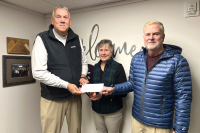A few moments – and 10 days – to celebrate cultural understanding
The end of this year’s Folkmoot USA, some of the acquaintances I made during the festival, and my own ongoing interest in all things political has led me along one of those idealistic wanderings that I’ve often tried to swear off. It’s cliché, I know, but I kept coming back to the truth that we should spend more time celebrating what we all have in common instead of fighting over what we disagree about.
A book I recently read probably contributed to the imaginary dance with what could be, as opposed to what is. I had little time to read in April and May, and so spent a long time getting through the popular Three Cups of Tea by Greg Mortenson. A book that should have taken a week at most to read sat on my nightstand for nearly two months as I pecked away at a chapter here and a chapter there.
This book has become required reading in many schools, and for good reason. It’s the true story of a mountain climber who almost died attempting to conquer K2, only to be saved by the villagers in one of the most isolated areas on earth. He came away with the notion that these people living in the mountainous areas of Afghanistan and Pakistan and their children — especially the girls — deserved an education.
Despite all our preconceived notions of Islamic fundamentalists, the very conservative village elders throughout the region welcomed Mortenson. As they saw how their children were empowered, and how Mortenson had no agenda except that of educating children who otherwise might not ever learn to read and write, they embraced the American and his simple goal of helping kids in these remote areas.
I thought about that book as this year’s 10-day Folkmoot international festival got under way (In the interest of disclosure, let me say that I am president of the Folkmoot board and have been a fan of this festival since I first arrived in Waynesville in 1992). Folkmoot doesn’t do anything as significant as building schools, but it has thrived for 25 years for many similar reasons, I think. Folkmoot touches lives on so many different levels.
When we begin planning for each festival, Folkmoot is a local event for almost everyone involved. Each of these groups was back home in their own country, trying to figure out how much money they needed, which members would be coming, when they would leave, and all those many preparations that go with international travel.
Related Items
As all the planning comes together and we are just a few weeks away from the start of Folkmoot, those of us in Western North Carolina also begin to get excited about this festival. I know my own children — Liam, Hannah and Megan — are a font of questions and queries about who’s coming, when will they arrive, what shows will we go to, how old are the dancers and on and on and on. By that time they are already learning about all these countries, saoking up knowledge without even knowing it.
As Folkmoot gets under way, we have close to 300 performers from all over the world housed with local guides, spending the day with bus drivers and volunteers, and interacting with Americans from many different socio-economic levels and age groups. It’s my hope that they leave with a better understanding of our values and firsthand experiences of our hospitality, thanks to those interactions and the audiences they perform for. And these performers also share much with us, offering a glimpse of their own culture, and doing so in many different ways.
We invite the different groups here for this festival and, after spending time with people from countries they have never visited, they leave. Again, we hope when they depart they do so with the realization that we are all more alike than different; that when we celebrate each other’s culture we foster a better understanding of this complicated world. That’s the simple message of Folkmoot we want to send home with these wonderful performers.
By my estimates, during its 26-year run Folkmoot has brought a total of more than 7,500 performers to these mountains to share their dance, their music and their heritage. A minimum of 2,600 volunteers and employees has been associated with Folkmoot over those years. Around 250,000 to 300,000 spectators have been to ticketed events over the 26 years of the festival, and that doesn’t include the huge audiences at each Parade Day and International Festival Day.
By any one’s count that’s a huge helping of international goodwill that we here in Western North Carolina are responsible for. Here is Folkmoot’s mission statement: “Folkmoot USA promotes world friendship and celebrates cultural heritage by hosting the North Carolina International Folk Festival and other programs for residents and visitors.”
I don’t want to over-emphasize the impact of this international festival that Western North Carolina has embraced so generously, but let us at least revel for a few moments in the fact that Folkmoot is indeed a unique and inspiring event.
(Scott McLeod can be reached at This email address is being protected from spambots. You need JavaScript enabled to view it..)









